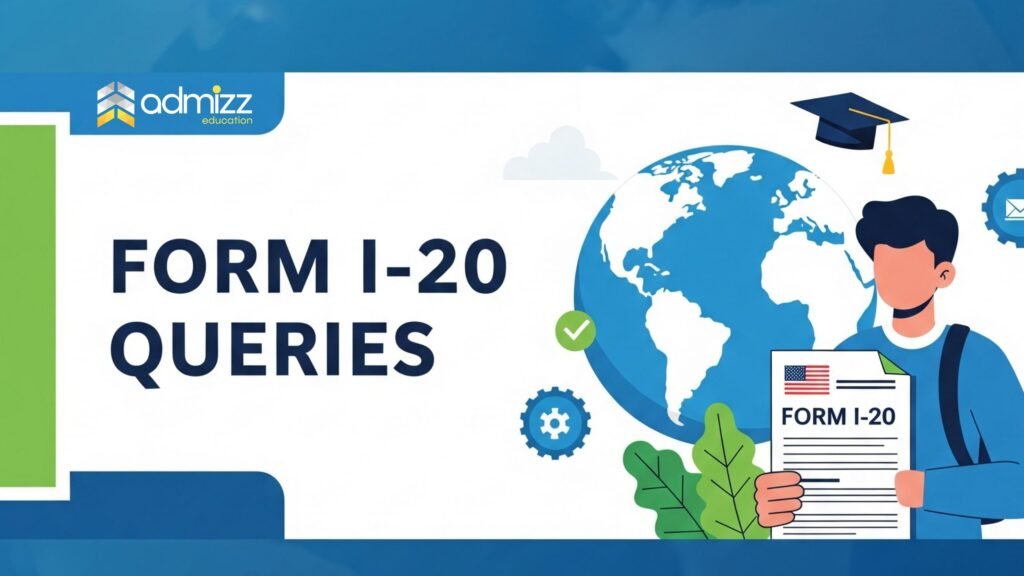Planning to pursue your academic dreams in the United States? The Form I-20 is one of the most critical documents you’ll encounter. Often referred to as the “Certificate of Eligibility for Nonimmigrant Student Status,” this guide provides a comprehensive overview of everything international students need to know about the I-20, from application to travel.
What is Form I-20?
The Foundation of Your US Student Journey
The Form I-20 is a formal document issued by a U.S. educational institution that is certified by the Student and Exchange Visitor Program (SEVP). It serves as official proof that:
- You’ve been accepted for full-time study at a SEVP-approved school.
- You meet the necessary academic requirements for your chosen program.
- You have demonstrated sufficient financial resources to cover your tuition and living expenses throughout your stay.
This document is absolutely mandatory for securing an F-1 student visa (for academic and language programs) or an M-1 student visa (for vocational programs).
Who Needs a Form I-20?
If you’re an aspiring international student aiming for an F-1 or M-1 visa, you must obtain a Form I-20. This requirement also extends to any eligible dependents (spouse or minor children) accompanying you; each dependent will require their own individual I-20 form.
Eligibility for Form I-20: Are You Qualified?
To get your hands on an I-20, you generally need to meet these key criteria:
- Acceptance by an SEVP-Certified School: Your chosen college, university, or vocational school must be approved by SEVP to enroll international students.
- Demonstrated Financial Ability: You must prove you have adequate funds to cover all your educational and living costs. This includes tuition, fees, housing, food, and other personal expenses.
- Academic Qualification: You need to fulfill the specific admission requirements of your program and institution.
- Full-Time Enrollment: You must be admitted into a full-time academic or vocational course of study.
How to Get Your Form I-20: Step-by-Step Application Process
The journey to obtaining your I-20 typically involves these crucial steps:
- Gain Admission to an SEVP-Certified School: This is your primary objective. Apply to and receive an official acceptance letter from a U.S. institution.
- Submit Required Documents to Your School: Once accepted, your school’s Designated School Official (DSO) will request specific documents to generate your I-20. Common requirements include:
- A clear copy of your passport’s biographical page.
- Proof of Financial Funding: This is paramount. Provide recent bank statements, sponsor affidavits, scholarship letters, or other official financial documents that meet the school’s estimated cost of attendance.
- Sponsor’s Affidavit of Support (if a family member or other individual is funding your education).
- Academic transcripts, diplomas, and standardized test scores (e.g., TOEFL, IELTS, SAT, GRE, GMAT), which you likely submitted during your admission application.
- School Issues Form I-20: After verifying your documents, your DSO will create your student record in the Student and Exchange Visitor Information System (SEVIS) and issue your official Form I-20.
- Sign Your Form I-20: Both you and your DSO must sign the Form I-20. If you are under 18, your parents or legal guardians must also sign. While digital I-20s are increasingly accepted, having a physical copy for your visa interview and entry is highly recommended.
Understanding Your Form I-20: Key Information Points
Your Form I-20 contains vital data that you’ll refer to repeatedly:
- SEVIS ID Number: A unique identifier that links your record to the SEVIS database.
- Personal Information: Your full name, date of birth, country of birth, and citizenship.
- Program Details: The name of your academic program, start date, estimated end date, and educational level.
- Estimated Cost of Attendance: A detailed breakdown of tuition, fees, living expenses, and other costs.
- Sources of Funding: Information on how you plan to finance your studies.
- School Information: Name, address, and SEVP certification details of your institution.
- Signatures: Your signature and the signature of the Designated School Official (DSO).
Form I-20 vs. F-1 Visa: What’s the Difference?
It’s crucial not to confuse these two essential documents:
- Form I-20: This is your Certificate of Eligibility, issued by your U.S. school. It confirms your acceptance and eligibility to study.
- F-1 Visa: This is a visa stamp placed in your passport by a U.S. Embassy or Consulate. It permits you to apply for entry into the United States as a student.
You must have your Form I-20 before you can apply for your F-1 visa.
The Role of SEVIS and the I-901 SEVIS Fee
- SEVIS (Student and Exchange Visitor Information System): This is the U.S. government’s online system that tracks international students and exchange visitors. Your DSO uses SEVIS to manage your I-20 record.
- I-901 SEVIS Fee: A mandatory fee (currently $350 for F-1 students, subject to change) that you must pay to the U.S. government after receiving your I-20 and before your visa interview or entry into the U.S. Your SEVIS ID from your I-20 is required for this payment. Keep the receipt!
Form I-20 Validity and Maintaining Your Student Status
- Program Completion Date: Your I-20 shows an estimated program end date. This is an estimate; your actual completion may vary.
- Maintaining Status: Your I-20 remains valid as long as you are continuously enrolled full-time and comply with all U.S. immigration regulations.
- Extensions: If you need more time to complete your studies, your DSO can extend your I-20 before its expiration.
- Grace Period: After program completion, F-1 students typically have a 60-day grace period to depart, transfer schools, or apply for Optional Practical Training (OPT). M-1 students have a 30-day grace period.
Travel Regulations with Your Form I-20
- Travel Signature: Before traveling outside the U.S. and planning to re-enter as a student, ensure you have a valid travel signature from your DSO on page 2 of your Form I-20. This signature is generally valid for one year (or six months if you’re on OPT).
- Required Documents for Re-entry: When re-entering the U.S., always carry:
- A valid passport (at least six months beyond your intended stay).
- A valid F-1 or M-1 visa stamp (Canadians are exempt from the visa stamp).
- Your original, signed Form I-20 with a current travel signature.
- Your I-901 SEVIS fee payment receipt.
- Copies of your financial support documents.
- Entry Window: You are permitted to enter the U.S. up to 30 days before the program start date listed on your Form I-20.
When You’ll Need a New Form I-20
Your DSO will issue a new Form I-20 in various situations, including:
- Changes to Personal Information: Updates to your name, date of birth, etc.
- Change of Program/Major: If you switch your major or degree level.
- Program Extensions: If you need more time to finish your studies.
- School Transfer: Your new school will issue a fresh I-20.
- Applying for Practical Training: For CPT (Curricular Practical Training) or OPT (Optional Practical Training).
- Lost or Damaged I-20: You’ll need a replacement.
- Significant Changes in Funding: If your financial sources change substantially.
Beyond Visa & Entry: Other Uses of Form I-20
The Form I-20 remains vital throughout your academic tenure in the U.S. You may need it for:
- Maintaining Legal Student Status.
- Applying for a U.S. driver’s license.
- Applying for a Social Security Number (if eligible for employment).
- Applying for authorized on-campus or off-campus work permits (CPT, OPT).
Form I-20 FAQs: Quick Answers to Your Questions
- How long does it take to get an I-20? Processing times vary by school and time of year, typically from a few days to several weeks after you submit all required documents.
- Can I apply for a visa with a copy of my I-20? While some consulates might accept a digital copy in rare cases, always strive to have the original physical Form I-20 for your visa interview.
- What if I lose my Form I-20? Contact your DSO immediately for a replacement. Do this before attempting to re-enter the U.S. if you are abroad.
- Is an I-20 the same as a visa? No, the I-20 certifies your eligibility to study, while the visa allows you to request entry into the U.S.
- Do my dependents need to pay the SEVIS fee? No, only the primary F-1 or M-1 student is required to pay the I-901 SEVIS fee.
Always keep your Form I-20 safe and accessible. It is paramount for your legal status and smooth academic journey in the United States. For any specific questions, always consult your school’s Designated School Official (DSO) or official government resources like Study in the States (studyinthestates.dhs.gov) and the U.S. Department of State (travel.state.gov).
Ready to Begin Your US Study Abroad Journey?
Navigating the complexities of university applications, financial documentation, and visa processes can be overwhelming. Let Admizz Education simplify your path to studying in the USA.
Don’t leave your dreams to chance. Partner with Admizz Education for a seamless journey.




